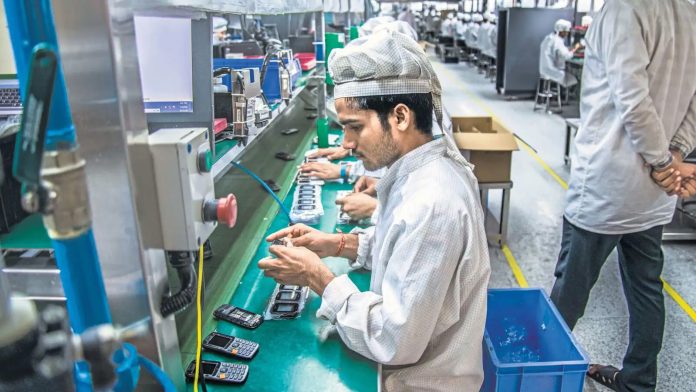Nantoo Banerjee
The vision document prepared by the Ministry of Electronics and Information Technology (MeitY) along with the India Cellular and Electronics Association (ICEA) outlining the target of the country’s electronics production in terms of US dollars at $300 billion by 2025-26 is too tall. Considering the country’s present production and export levels, the target appears to be highly unachievable. India’s electronics production may at the most reach a $200-billion mark by the end of March 2026. The country’s current electronics production is only worth a little over $100 billion. This includes electronics exports which earned $23 billion in 2022-23. There is absolutely no doubt that the country has done extremely well in electronics production and exports in recent years. India is now the world’s second largest mobile phone manufacturer. The country’s smartphone market has also grown to become the second largest. The production of mobile phones has gone up from 60 million in 2015 to 310 million in 2022 at a CAGR of 26 percent. Yet, these figures mean little in the context of global electronics production and exports.
Interestingly, the minister in charge of the department, Rajeev Chandrasekhar, has been constantly harping on the $300-billion production target for 2025. The figure includes electronics exports worth $130 billion. Such a level of electronics production will naturally create millions of new jobs in the country by the end of 2025-26. The purpose behind the government campaign appears to be more political than real. On ground, the manufacturing target appears to be highly exaggerated. And, so are the exports and employment projections. In fact, employment in the country’s manufacturing sector has been shrinking in recent years. From employing 51 million people in 2016-17, employment in manufacturing, which accounts for 17 percent of the country’s gross domestic product (GDP), declined by 46 percent to reach 27.3 million in 2020-21.
This also reflected the severity of the employment crisis caused by the Covid pandemic. However, things have not improved much since then. A high growth in electronics manufacturing and exports can substantially change the situation. This could be a reason behind the minister’s frequent harping on unreasonable electronics production and export projections for 2025-26 and job generation targets. Possibly, they will also find a mention in the Bharatiya Janata Party’s Lok Sabha election manifesto, next year. The terms of the present government at the centre ends in May, 2024. Effectively, the onus of meeting the vision target is on the next government.
As mentioned earlier, the vision paper has set the country’s electronics export target at $130 billion. Suffice it to say that the electronics export market is highly competitive and India does not feature even in the list of 15 top electronics exporting nations. The country accounts for a little over one percent of the global electronics trade. Among the major electronics exporters by country during 2022-23 were: China ($671.5 billion), the US ($192.5 bn), Japan ($154.7 bn), South Korea ($129.4 bn), Germany ($101.7 bn), Taiwan ($94.8 bn), Singapore ($60.4 bn) and the Netherlands ($57.5 bn). Even small countries such as Singapore, Vietnam, and Malaysia cumulatively export electronics products worth over $100 billion annually.
The MeitY vision paper has set a short-term export target at $130 billion. With around 20 percent of the global workforce are said to be involved in the electronics business, a $130-billion export market could mean an engagement of 15 million in direct jobs in India. The size of the global consumer electronics market was valued at $720 billion in 2021. The worldwide consumer electronics market is expected to reach $1000.90 billion by 2030, according to a research report published by Spherical Insights & Consulting. India’s impetus in the tech and digital manufacturing sector will create as many as five million jobs in the next three years, said Rajeev Chandrasekhar.
Following on the path of import substitution, the MeitY vision document foresees that the country’s domestic electronics market would reach around $150-180 billion from the current level of $65 billion over the next 4-5 years. “Thus, exports of $120-140 billion are critical to reach the $300-billion mark for electronics manufacturing in 2025. This, in turn, is key for the five-trillion-dollar economy, one trillion dollar digital economy, and a trillion-dollar export target envisaged by MeitY and the Ministry of Commerce and Industry, respectively,” the Vision Document 2.0 read. “India is one of the leading contenders for alternate solutions for global electronics companies.
The electronics sector has the potential to become one of the top exports of India in the next 3-5 years. Electronics exports may account for significant contributions to the Indian economy in terms of foreign exchange earnings and employment generation,” said the document. Electronics is the largest manufactured and traded category globally, valued at over $2 trillion, of which China supplies almost over 50 percent. India’s share in global electronics manufacturing has grown from 1.3 percent in 2012 to 3.75 percent in FY 2022.
While India’s rapid progress in electronics manufacturing in recent years is highly commendable, an important thing is that the next phase of its growth will substantially depend on domestic production of semiconductors and microchips. Microchip is a tiny wafer of semiconducting material used to make an integrated circuit. Electronics encompasses one of the broadest ranges of consumer products in the modern world — from TV sets to computers, music players, smartphones, tablets and watches among many others. It has been one of the most transformative industries in the world for the last 50 years. Unfortunately, it is only in the fag end of the Narendra Modi government’s second term that the administration is seriously trying to attract investments in this sector by heavily granting incentives to bring in at least a few leading global semiconductor manufacturers to produce the all-important crystal material. Time alone will tell if the efforts will ultimately produce positive results. (IPA )


